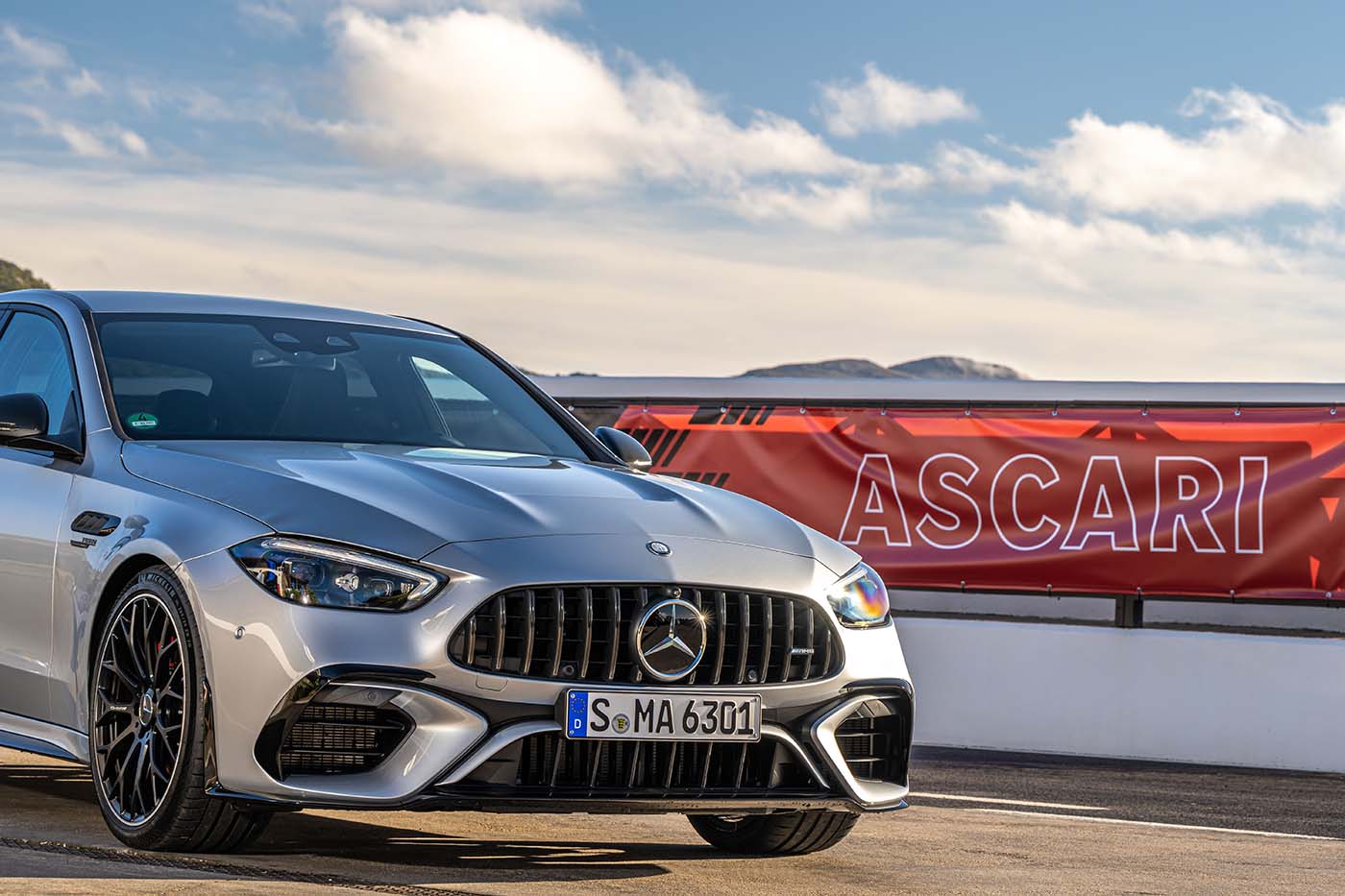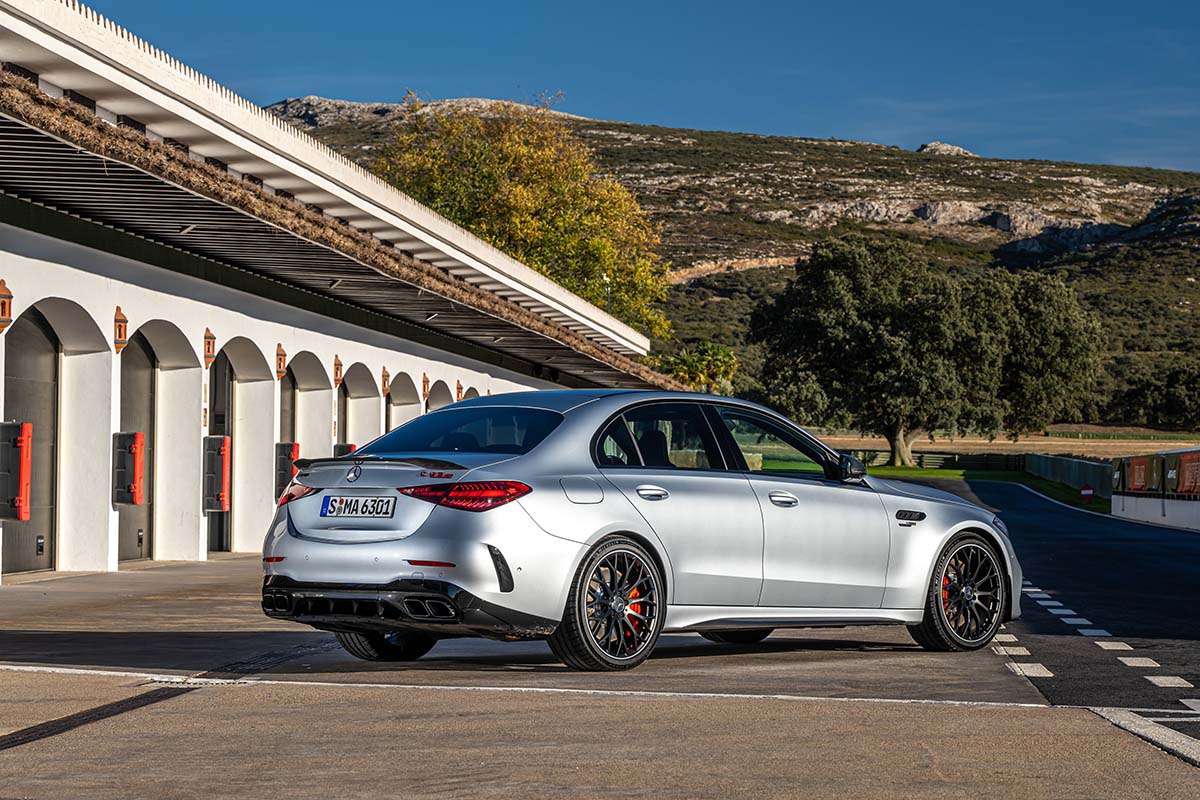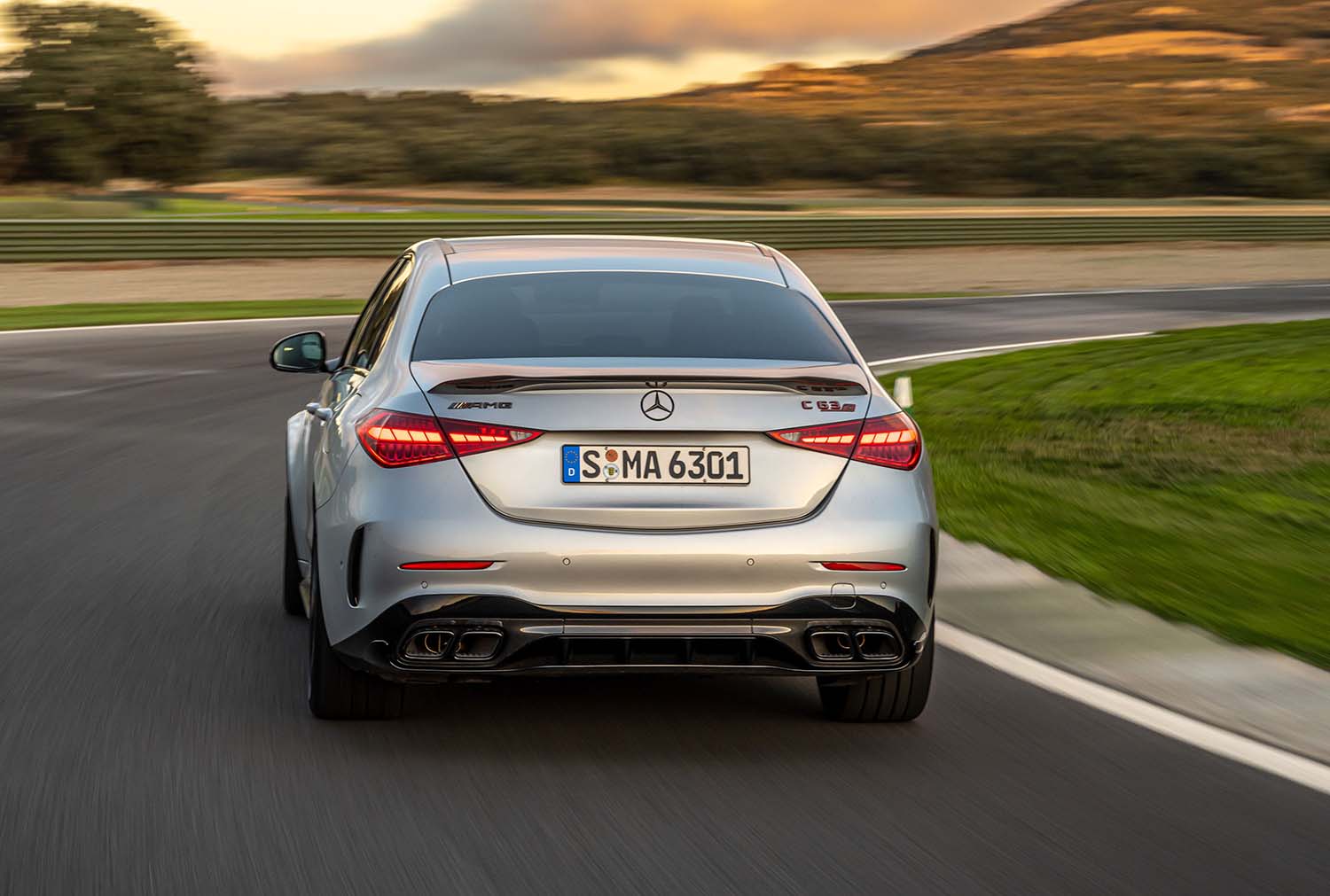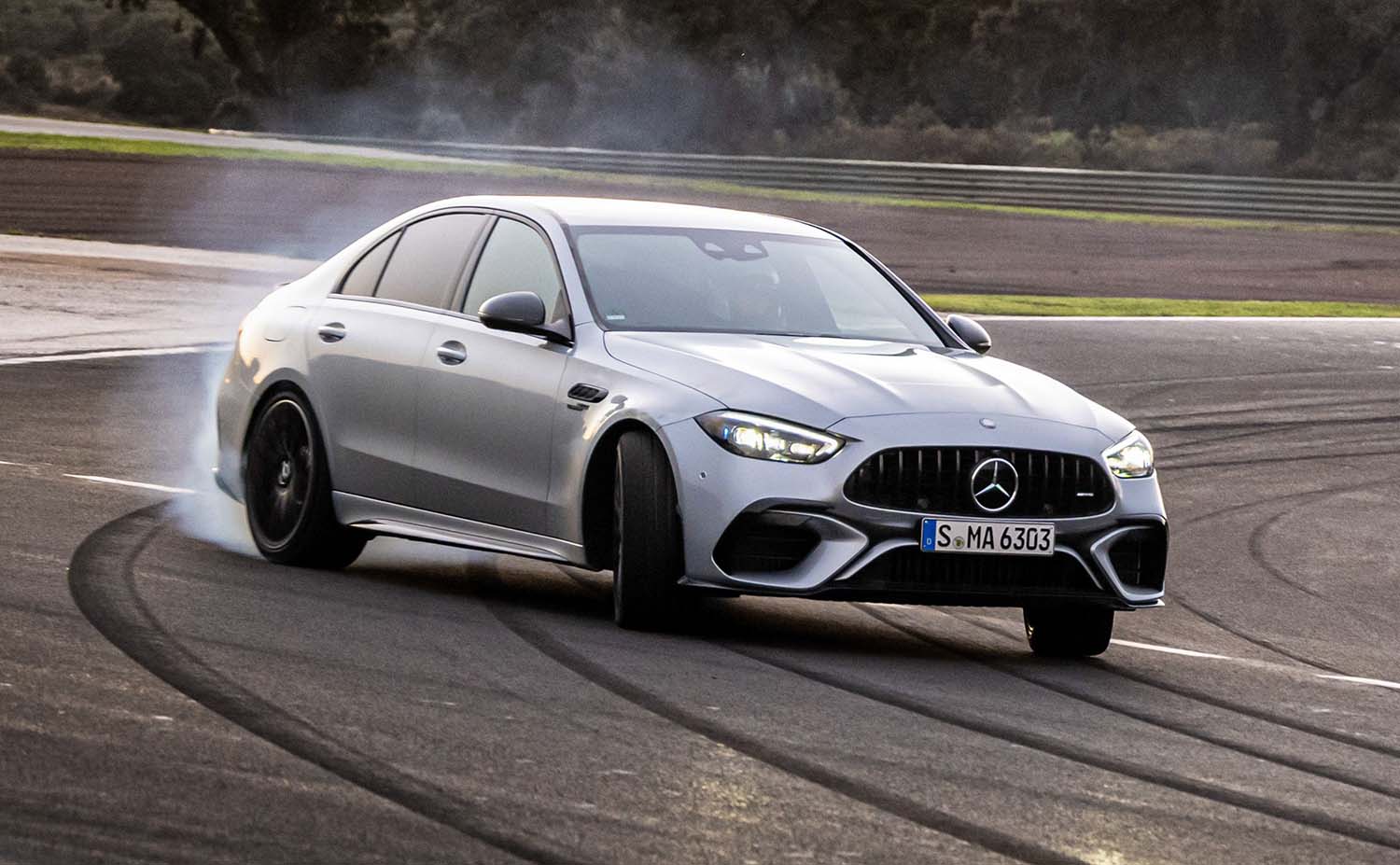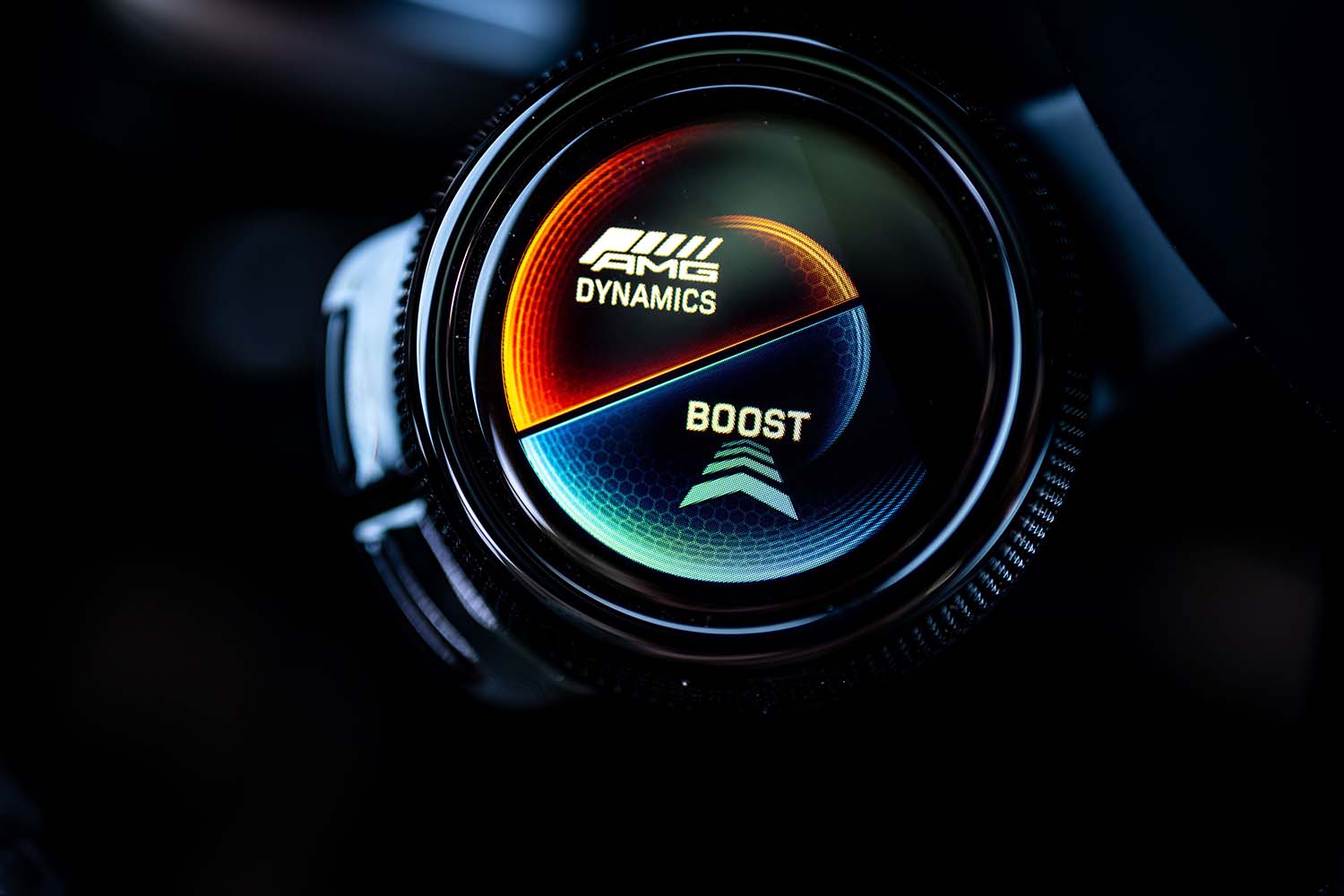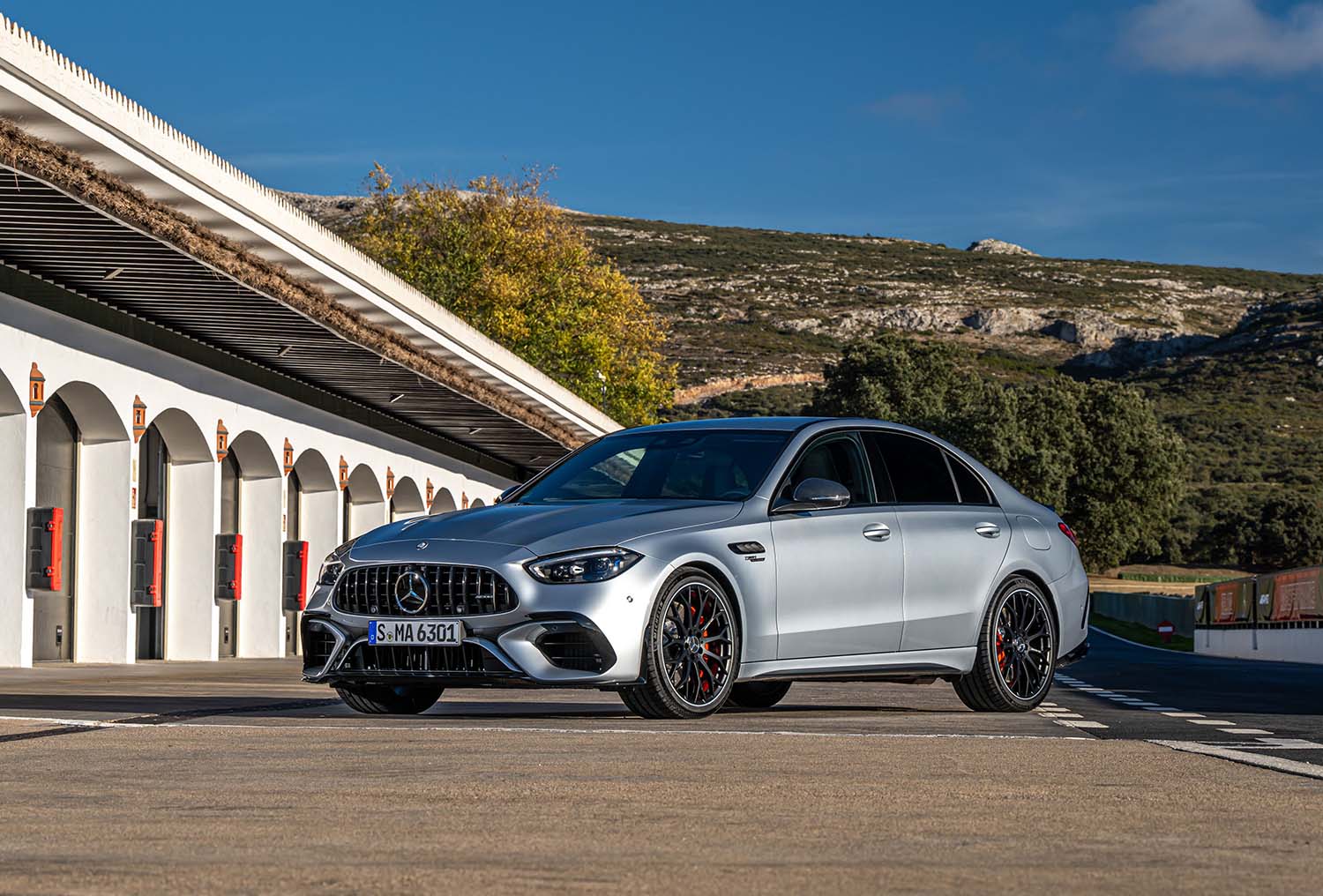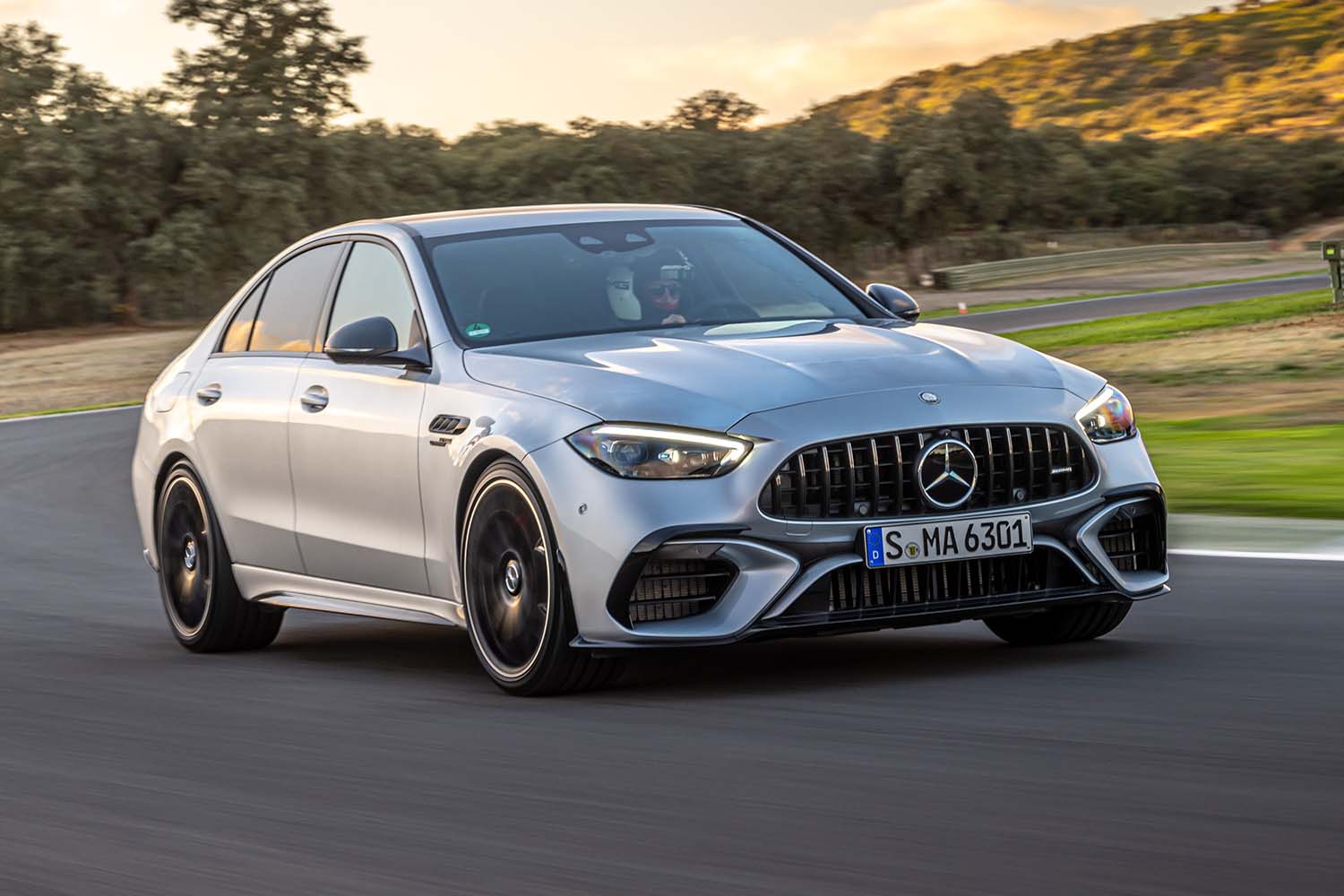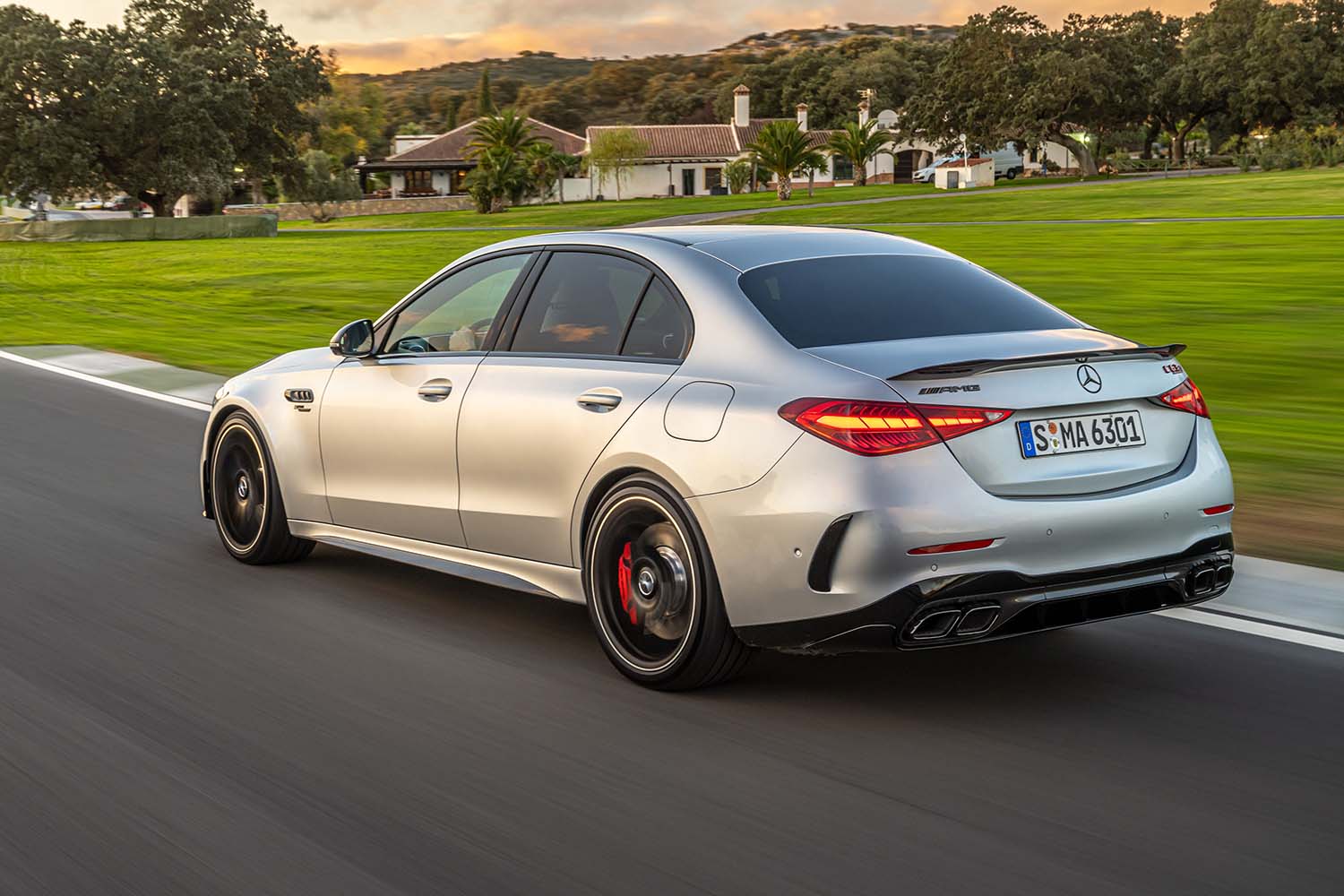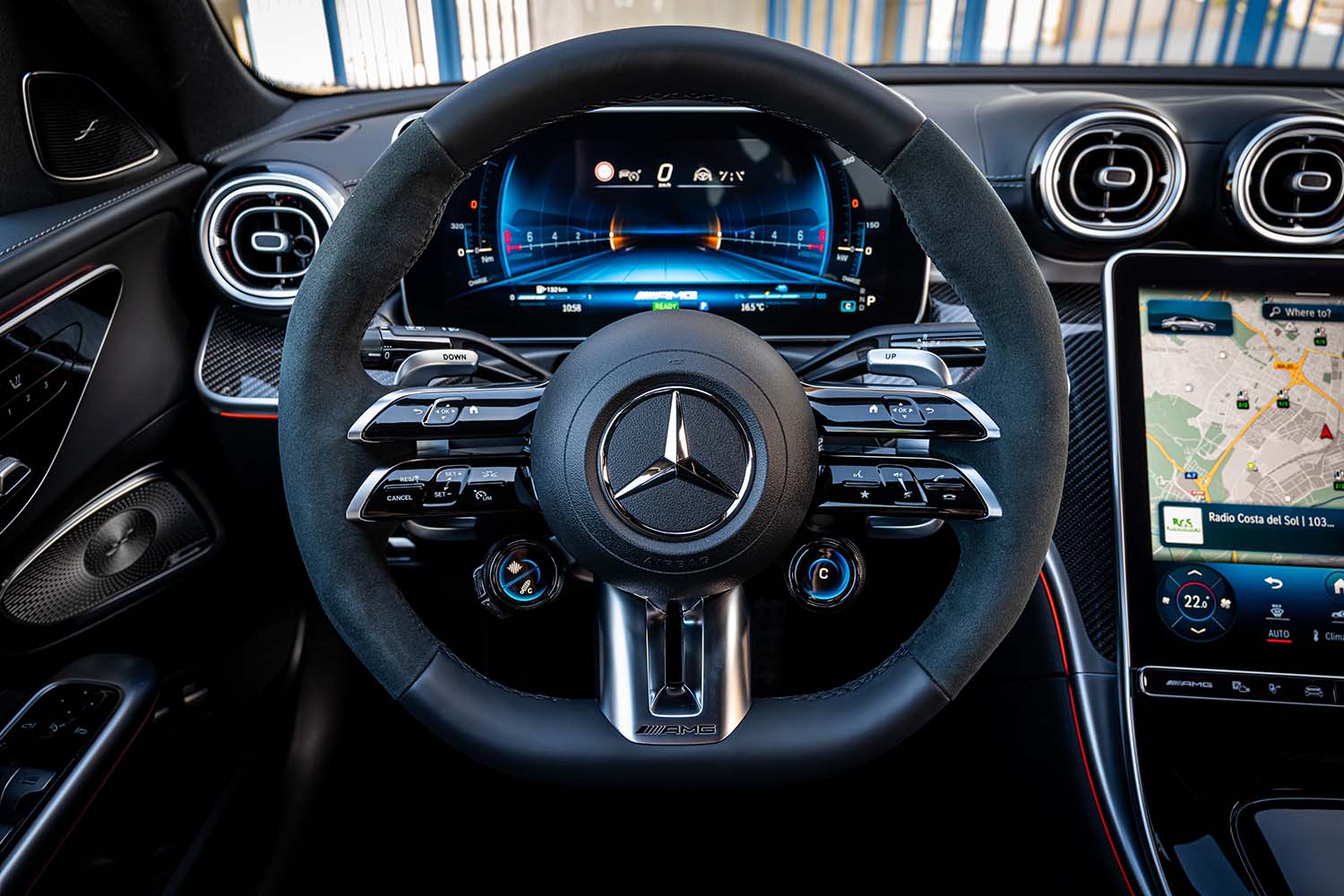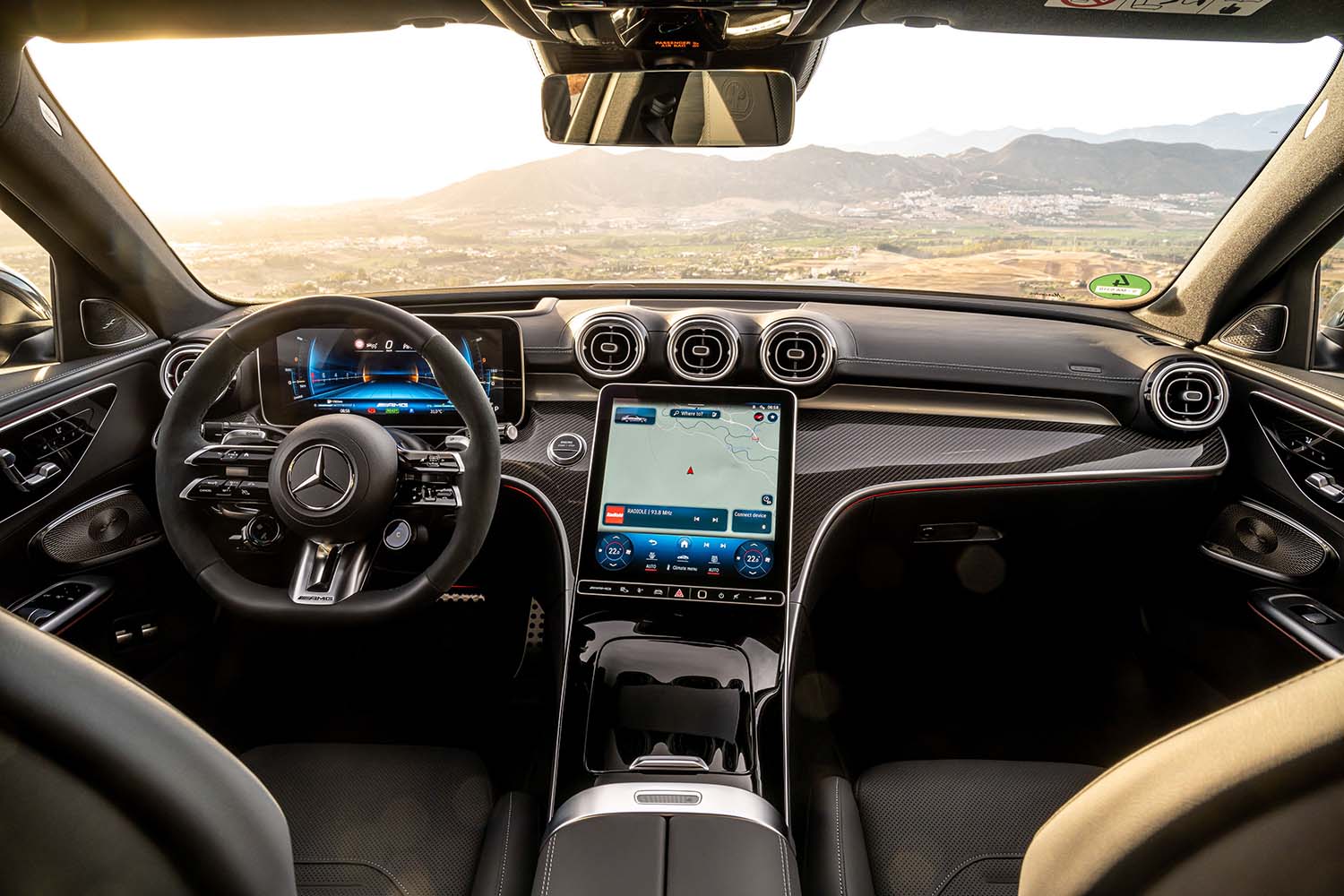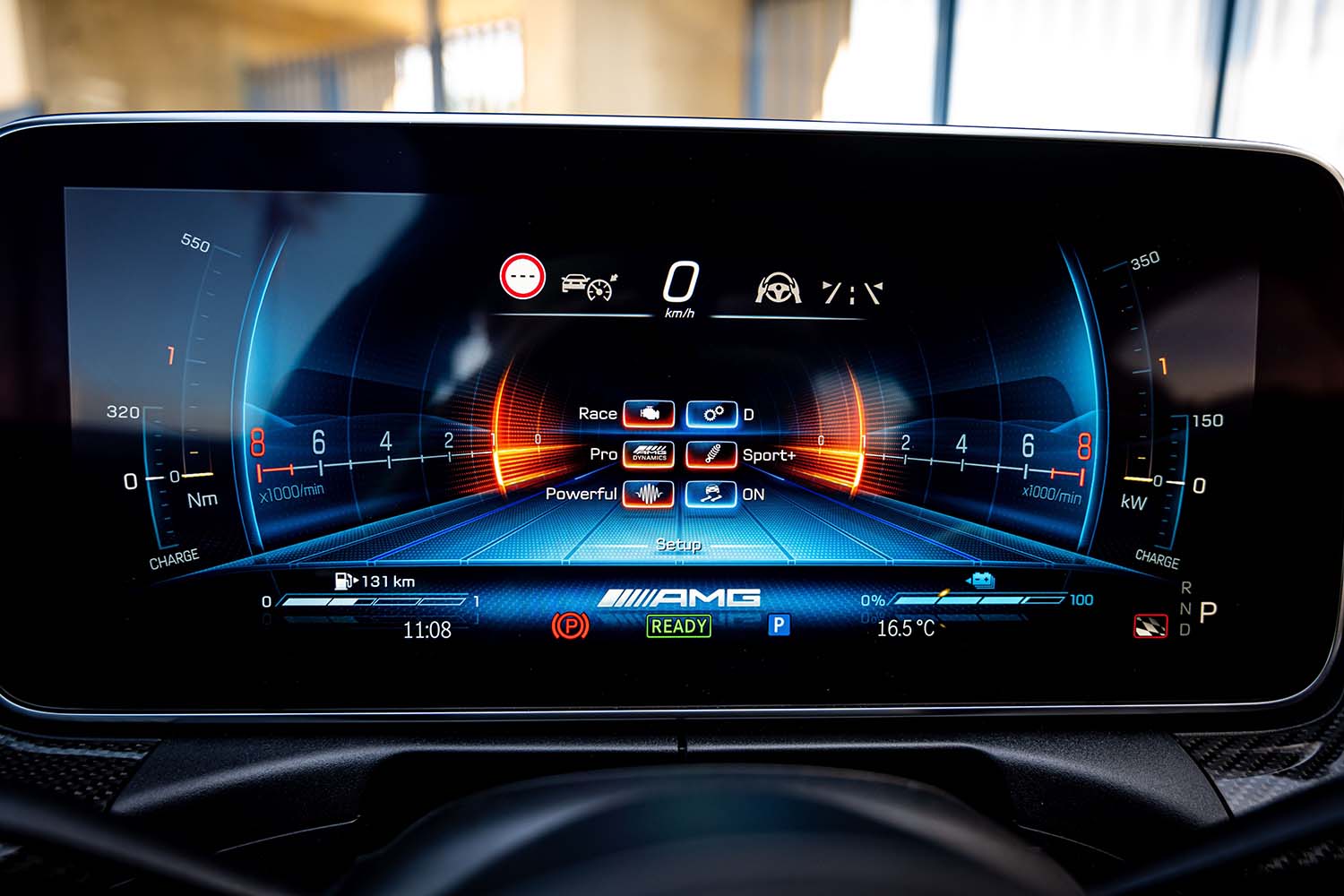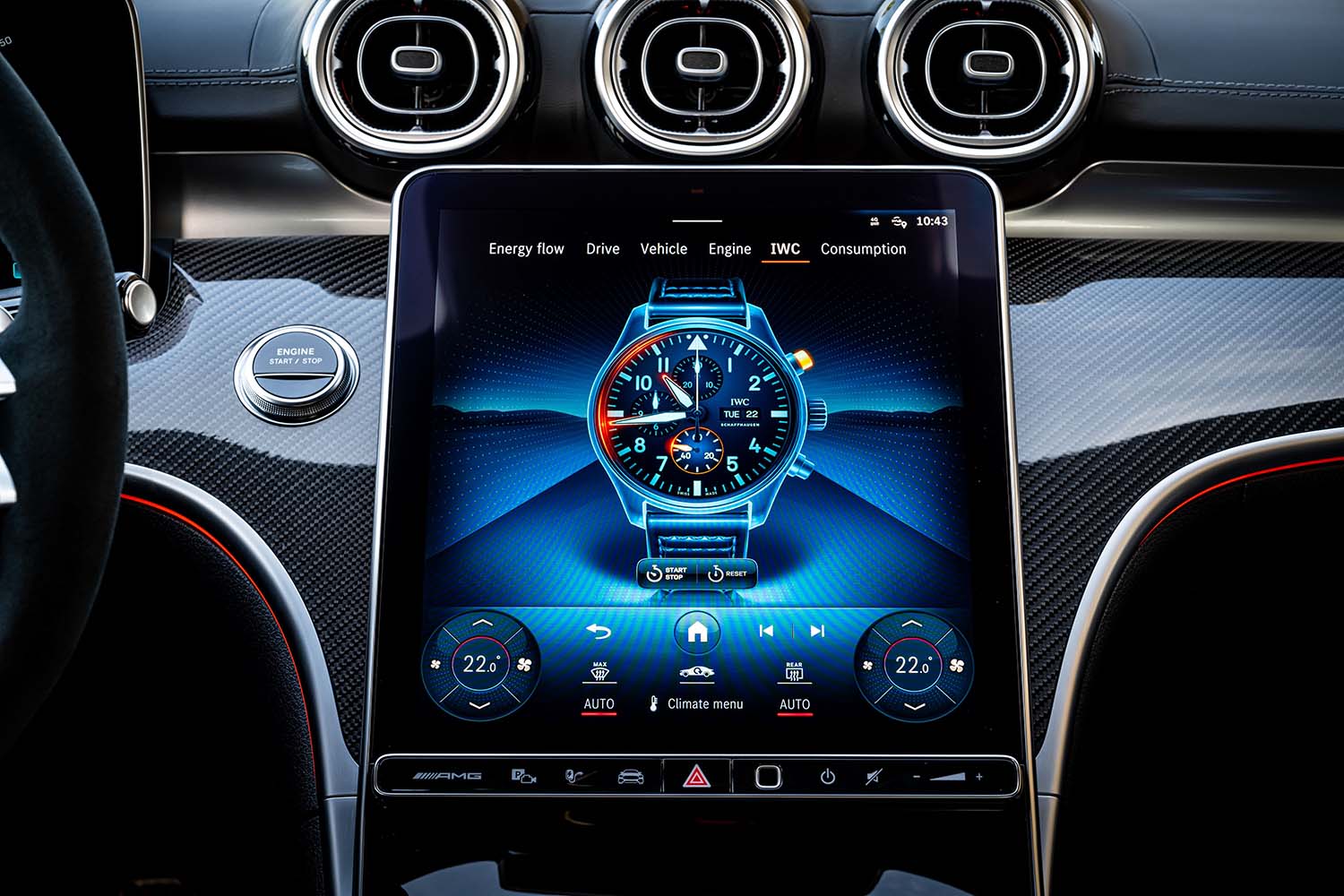Mercedes-AMG’s new-generation C63 S E Performance has a legacy of thundering V8 models to follow. Can the staggering 500kW combination of turbocharged four-cylinder engine and electric motor stay true to the legendary badge?
Just… t-h-e-r-e. It’s a fleeting sensation and one that you need to be searching for, but at two points on Ascari Race Resort’s fabulously fast and tricky layout you can feel the weight of the new Mercedes-AMG C63 S E Performance. Much has been (and will be) made of the 2165kg weight of the new-gen C63, but let me tell you, it is so close to a non-issue that it’s barely worth highlighting. Indeed, I’m deliberately highlighting it because, within the scope of the C63’s performance and everyday liveability, the weight almost never intrudes.
Ascari has numerous points of minimal run-off and the consequences of a small mistake could become very big, very quickly – especially in something as ballistically fast as the C63 S E Performance. After a couple of speedy sighters, DTM legend Bernd Schneider’s voice crackles over the radio that it’s time to push and I do my best to follow in the tyre tracks of his identical C63. Speaking of tyres, it’s worth noting that the new AMG is running Michelin’s Pilot Sport 4S tyres rather than sticky Cup 2s (Schneider later reveals that he’s 3.5 seconds quicker around Ascari with Cups fitted).
This is only my third time driving at Ascari but my memory of the C63 S Coupe launch from 2015 reminds me that there are a couple of points on the circuit where the heavier C63 S E Performance might struggle.
The first is just after the start/finish line on the pit straight where you brake hard into a shallow downhill left before flicking into an uphill right/left combo over a brow. I remember the C63 S Coupe developing reasonable yaw angles through this super quick change of direction as the weight was mobilised under braking with the suspension working overtime to maintain control through the direction change. I’m prepared for more of the same in the heavier new-gen sedan but it never comes.
It’s a big brake application from over 200km/h, the first part of which is in a straight line, but mid-way through the process, the circuit drops and kinks slightly to the left. At 50km/h you’d barely notice it, but add 100km/h and it’s enough to require a tiny steering input and enough, if you’re really paying attention, to shift the back of the new C63 a degree or two to the right. The weight transfer doesn’t require any corrective lock, instead you use it to fire the car back to the right for the first part of the flip-flop. Lap after lap it’s easy to exploit this weight transfer, lifting out of the brakes and transitioning quickly to full power (of which there is immense amounts). It’s a mesmerising and very fast process.
The second part of the circuit where you can detect the weight of the new car is over the back, again on a cresting change of direction. You fully load the suspension through a left-hand compression before climbing to the right and eventually cresting to the left. It’s an even faster part of the circuit than the flip-flop after the straight but again the C63 shrugs it off with a balance of control and communication that breeds confidence.
And that’s it. After multiple hard-driven sessions on Ascari, trying to keep pace with the one-speed (flat-out) Bernd Schneider, and hundreds of kilometres on twisting Spanish mountain roads, the C63’s weight really was a non-issue. Indeed, the brakes never faded after multiple track sessions and the tyres were remarkably consistent in their grip and wear rates. Yes, you could overwhelm and heat up the right front tyre around Ascari’s multitude of fast left handers, but inspection after the lapping was done revealed consistent wear across the face with no tread separation (a tell-tale of poor weight/tyre management).
The second elephant in the room, or maybe the first, relates to the sound of the new C63. Unlike so many other car brands, AMG is willing to acknowledge that a turbocharged four-cylinder – even one with 350kW and augmented by a 150kW electric motor – cannot hope to match the aural thunder of the outgoing twin-turbocharged 4.0-litre V8. So, it didn’t try. What is somewhat of a surprise, however, is that the new car doesn’t sound like an even more feral A45. Instead, and regardless of dynamic mode, it is rather subdued. Too subdued? Certainly, for some current C63 owners it won’t be raucous enough, but on the flip side, the new car will appeal to a range of buyers for whom the V8 was too shouty. Personally, I fall somewhere in between.
But let me rewind. The new C63 S E Performance is one of the most technically advanced/complex cars ever made. The smallest of AMG’s super-sedans now also possesses a set of numbers like nothing else: consider 500kW, 1020Nm and a kerb weight of 2165kg. Whichever way you look at it, the new C63 is a giant.
The new car uses the rather special M139 four-cylinder 2.0-litre engine from the A45 and C43, but with a larger turbocharger to produce a huge 350kW and 545Nm, making it the most powerful series-production four-cylinder engine in the world. It’s mounted longitudinally (hence the M139l code) under the bonnet and connected to the usual nine-speed DCT gearbox. From there, drive is taken to a centre differential – yep, the new C63 is all-wheel drive – and that’s where it then meets the other propulsion source, which is a combined battery, electric motor and electronically controlled differential unit mounted on the rear axle.
The electric motor produces up to 150kW and 320Nm, and is powered by the 6.1kWh battery pack; the complete hybrid system weighs around 250kg, with the battery pack weighing in at 89kg. It’s worth noting that the 1020Nm peak torque figure is arrived at due to the multiplying effect of the two-speed gearbox that is driven by the electric motor.
The mix of EV and ICE power is the really clever part, of course, with knowledge taken from the firm’s F1 exploits, and drive is then also taken to the front axle depending on the mode selected, road conditions, etc. Naturally, the C63 has a drift mode, where the centre clutch is left open and the car is permanently rear-wheel drive with both sources working together. Otherwise it can distribute torque almost infinitely to wherever it’s required.
The engine also has a belt-driven starter motor and generator that powers the car’s ancillaries, but unlike the system used elsewhere by Mercedes-Benz it doesn’t feature a separate 48V electrical system, but rather the engine’s ancillaries and the trick electric turbocharger (to eliminate turbo lag) are now integrated into a 400V electrical set-up that works with the high-voltage requirements of the C63’s hybrid system.
The 6.1kWh battery is unique to AMG and designed specifically with fast discharge and recovery characteristics in mind, so the car can only manage 13km of purely electric running on a full charge (though we did eek out an indicated 16km departing central Malaga on the second day of the launch programme). Owners won’t have to plug in the car, unless for pre-conditioning the car’s interior in extreme weather.
Of course, the reason for all this change is improving the C63’s eco credentials, and fuel economy is rated at 6.9L/100km on the combined cycle. In many ways, this car is a response to what the market has been asking for. AMG tells us that some of its customers found the outgoing car too much of a handful, with its 375kW V8 driving the rear wheels only, so the fact that the new C63 can transform into a ‘normal’ C-class when simply commuting will be a positive. AMG also expects that the new car’s ability to be silent for the first and last kilometres of its journey to be a major plus point for many customers, just as the improved traction from having all-wheel drive should make the car less threatening – even if it does actually have a lot more power than before.
Fitting everything into the new C-class body has been no small task for AMG. The wheelbase has been lengthened by 50mm (between the A-pillar and front axle), this time not to make room for a large engine but to fit in all the additional cooling required by both ICE and EV powertrains. Widening the front guards by 73mm has enabled the fitment of broader tyres (265/35 ZR20 up front and 275/35 ZR20 at the rear), while the swollen arches provide that threatening AMG look. Standard wheels in Australia will be 20-inches in diameter (19s are standard in some markets) and the standard-fit tyres are Michelin Pilot Sport 4S. The 390mm front brake discs with six-pot calipers can be upgraded to carbon-ceramics as an option.
The front suspension geometry has been reworked, including new steering knuckles, plus more aggressive negative camber and toe angles, but the basic layout is the same as the C43’s. The rear axle has been re-tuned as well and now features rear steering that turns in an opposite direction to the front wheels below 100km/h, and with them over that speed.
The suspension itself is via coil springs with electronically adjustable and constantly variable dampers at each corner, inspired by AMG’s GT3 cars. The shell has been stiffened by the fitment of the battery pack at the rear (which also helps give a 50:50 weight distribution, front to rear). At the front, a shear panel under the engine improves the aerodynamics and also stiffens up the body, as does a strut brace.
One thing that hasn’t changed much is the look of the car – perhaps to try to suggest some continuity given the amount of change under the skin. One addition is a vent between the twin AMG power domes on the bonnet – not strictly necessary, according to the engineers, although not fake either, but some customers wanted a little more visual clout than previously we’re told.
Inside there are bespoke AMG sports seats and an AMG-specific steering wheel, but otherwise it’s the same as the regular C-class models. One obvious compromise is the reduction in boot space thanks to the pack of EV components, which results in a raised ledge that spans the boot floor.
Naturally, there is a plethora of driver modes available, including a boost function, the idea being that some of the electric motor’s thrust is kept back during circuit driving and can then be summoned at the appropriate moment by accessing the kickdown on the accelerator pedal. Apparently during testing it was found that an inadvertent spike of torque from the electric motor could seriously upset the balance of the car during on-the-limit cornering, while having all the electric power available continuously soon depleted the battery. It’s a clever system and one that was deployed at various points on Ascari’s fast layout to stunning effect.
GLIDING THROUGH MALAGA’S SLEEPY MONDAY morning streets in electric mode is certainly a new experience after I’d clocked the C63 S badge on the rump as I was loading bags into the boot. There’s plenty of urge in EV mode and the braking regen is natural and not overwhelming, even when in its most eco-friendly setting.
Malaga’s streets are generally smooth, but cobbled sections and disused rail lines near the harbour are shrugged off in a manner that the old car couldn’t hope to match (I spent a week in a C63 S Coupe just before departing for this launch). It all feels very C-class – a comment that could be taken as a compliment or criticism depending on what you want from your C63. Given the breadth of ability of the new car, I mean it very much as a compliment.
Not long after the EV range is depleted and the petrol engine has thrummed into life, the roads begin to recoil and climb away from the coast. These are fabulously challenging roads; narrow in places with tricky cambers to catch you out and a lack of guard rails to give you something of a sense check. And while the roads are generally smooth, occasional sections of subsidence create ripples and dips in the pale grey tarmac that are impossible to detect until you’re right on top of them. Regardless, the new C63 simple shrugs off the road with taut body control married to a suppleness that encourages you to maintain pace over iffy tarmac.
At no point on road or track does the C63 S E Performance feel obviously all-wheel drive, nor is it easy to detect the rear-steering in operation (some systems exhibit a spooky floatiness as you turn into high-speed corners). Instead, the chassis just exudes confidence, feeling locked down, direct and endowed with otherworldly grip. Even with ESC dialled back (or briefly off), the chassis will accept vast amounts of throttle right at the apex. There’s the occasional squirm from the back axle, but a similar amount of throttle in the old car would require a visit to the lockstops.
The steering isn’t brimming with feedback, but it’s direct and accurate, allowing you to place the C63 with confidence and precision. It’s amazing how quickly you can pick apart a challenging ribbon of tarmac, a task made easier by brakes that don’t wilt under pressure.
Where both the original 6208cc naturally aspirated C63, and the outgoing twin-turbocharged 4.0-litre model provided plenty of aural warnings not to poke the bear, the new, quieter C63 stuns with its speed. The head-up display is scrolling through to big speeds between corners that seem at odds with the soundtrack.
And that’s that. Our first drive of the new C63. There’s plenty to take in and we’re keen for more wheel time to truly understand such a complex car. We won’t get our next taste until the car arrives in Australia from July 2023. Given that the local launch is so far away, Mercedes-Benz Australia hasn’t confirmed pricing, but given the leap in technology and performance, expect a jump in pricing to over $200,000.




